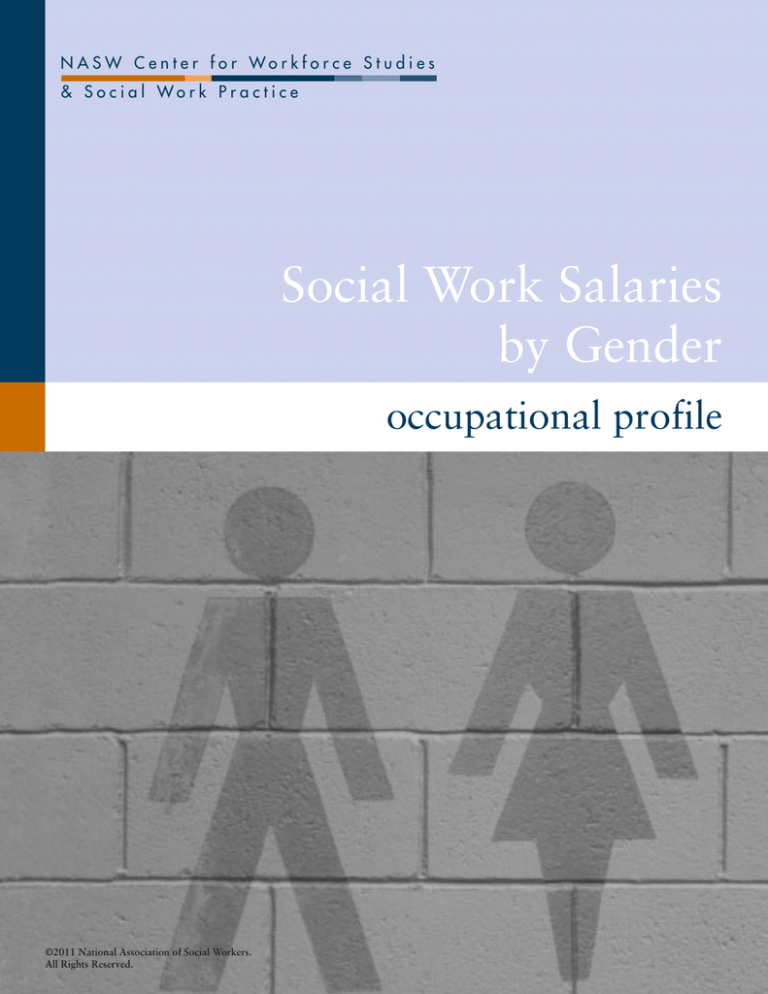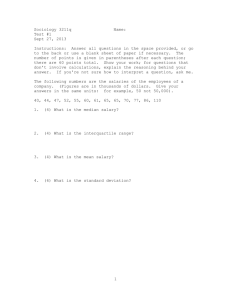
N A S W C e n t e r f o r Wo r k f o r c e S t u d i e s
& S o c i a l Wo r k P r a c t i c e
Social Work Salaries
by Gender
occupational profile
©2011 National Association of Social Workers.
All Rights Reserved.
Overview
In general, women earn less for their work than men. Even with an increased participation and a recognized critical role in
the labor force, the wage gap for women remains. Since the 1960s, political and legislative agendas have championed
equal work for equal pay, however, these efforts have failed to eliminate the problem (Gilbelman, 2003).
When the Equal Pay Act of 1963 passed, women received 59 cents for every dollar earned by men. In 2009, over
40 years later, the wage gap for women narrowed to 77 cents, yet still existed. For African American women and
Latinas, the pay gap remains significant in comparison to both Caucasian men and women.
Gender-based pay inequity remains a persistent problem for social workers and other female-dominated professions.
Male-dominated occupations consistently pay more than female-dominated occupations at similar skill levels. In 2007,
the U.S. Census Bureau surveyed women’s and men’s median pay and found that women’s median pay was less than
men’s in each one of 20 industries and 25 occupation groups. Therefore, addressing occupational segregation is an
important part of redressing the gender pay gap (Institute for Women’s Policy Research, 2010).
occupational profile
Even men working in female dominated occupations were found to earn more than women in the same occupation
(National Organization of Women, 2004). This finding was supported in an NASW workforce study of licensed social
workers that revealed a significant gender gap in salaries for licensed social workers (Whitaker, Weismiller & Clark,
2006). The raw difference in average salaries for men and women working full-time in a single social work job was
$12,045. When other factors (including age, race, geographic area, highest social work degree, rural/urban setting,
size of caseload, practice area, employment sector, and years of experience) were controlled, the average salary gap
dropped to approximately $7,052. Since the mean salary for these individuals was about $51,192, the percentage
gap was approximately 14 percent (Whitaker et al, 2006).
Subsequent analysis of the study further revealed that the gender composition shifted dramatically between the highest and
lowest salary levels (NASW Center for Workforce Studies, 2007). Eighty-nine percent of the lower earners were women,
compared with 57 percent of the higher-earning women. In contrast, only 11 percent of the lower earners were men,
compared with 43 percent of the higher-earning men. In general, social workers who earned higher salaries were more
likely to be older, male, to hold an MSW as their highest degree, and be licensed in more than one state (NASW Center
for Workforce Studies, 2007).
History and research indicates that the issue of equal work for equal pay remains a recognized and constant social
problem for women. Even though there has been national legislative, policy and judicial recognition of this matter, the
problem persists—continuing to have a disproportionately negative effect on the financial stability of working women
and their families.
REFERENCES
Gilberman, M.(2003). So how far have we come? Pestilent and persistent gender gap in pay. Social Work, 48, 22-32.
Institute for Women’s Policy Research,(2010). The gender wage gap by occupation fact sheet. Retrieved from:
www.iwpr.org/pdf/C350a.pdf
NASW Center for Workforce Studies, (2007). More money- Less money: Factors associated with the highest and lowest
social work salaries. Retrieved from http://workforce.socialworkers.org/whatsnew/salaryreport.pdf
1
National Organization for Women,(2004). Women deserve equal pay. Facts about pay equity. Retrieved from:
www.now.org/issues/economic/factsheet.html
Whitaker, T., Weismiller, T., & Clark, E. (2006). Assuring the sufficiency of a frontline workforce: A national study of
licensed social workers. Executive summary. Washington, DC: National Association of Social Workers.
Data referenced in this profile are based upon results from the 2009 NASW Salary & Compensation Study (see Notes).
Salary Analysis of Social Workers by Gender and
Practice Setting
SOCIAL WORKERS IN SOLO PRACTICE (N=3,298)
ANNUAL SALARY BY GENDER
Social Work Salaries by Gender
2
SOCIAL WORKERS IN MENTAL HEALTH CLINICS & OUTPATIENT FACILITIES (N=1,836)
ANNUAL SALARY BY GENDER
occupational profile
3
SOCIAL WORKERS IN HOSPITALS AND MEDICAL CENTERS (N=1,577)
ANNUAL SALARY BY GENDER
SOCIAL WORKERS IN SCHOOL SETTINGS, K-12TH GRADE (N=1,358)
ANNUAL SALARY BY GENDER
Social Work Salaries by Gender
SOCIAL WORKERS IN SOCIAL SERVICE AGENCIES (N=1,178)
ANNUAL SALARY BY GENDER
4
SOCIAL WORKERS IN GROUP PRACTICE (N=1,120)
ANNUAL SALARY BY GENDER
occupational profile
5
SOCIAL WORKERS IN COLLEGES AND UNIVERSITIES (N= 945)
ANNUAL SALARY BY GENDER
SOCIAL WORKERS IN HOSPICE AND PALLIATIVE CARE [N = 940]
ANNUAL SALARY BY GENDER
Social Work Salaries by Gender
SOCIAL WORKERS IN HEALTH CLINICS AND OUTPATIENT FACILITIES (N=784)
ANNUAL SALARY BY GENDER
6
SOCIAL WORKERS IN GOVERNMENT AGENCIES (N=539)
ANNUAL SALARY BY GENDER
occupational profile
7
SOCIAL WORKERS IN PSYCHIATRIC HOSPITALS (N=454)
ANNUAL SALARY BY GENDER
Survey Methodology
This survey was sponsored and developed by NASW. Data was collected and tabulated by Readex Research, an
independent research company. To broaden representation of the profession, NASW partnered with a number of other
social work membership organizations to create an expanded list of U.S. professional social workers for sampling
purposes. These partner organizations were:
■
Association for Oncology Social Work (AOSW)
■
National Hospice & Palliative Care Organization (NHPCO)
■
National Network for Social Worker Managers (NNSWM)
■
The Rural Social Work Caucus
■
Society for Social Work Leadership in Health Care (SSWLHC)
The total number of unduplicated individuals among these five lists and the NASW domestic membership was 101,995.
The overall sample size of 78,777 consisted of the 73,777 with a valid email address on file and a systematic sample
of 5,000 (among the 28,218) who could not be reached via email.
Data was collected between October 1 and November 24, 2009. A total of 23,889 unduplicated usable responses
were received, for a 30% response rate. Among these, 22,000 responses were randomly chosen for inclusion in the final
tabulation. The data has been weighted to account for disproportional response between the email and regular mail
samples. Percentages based on all 22,000 responses are subject to a margin of error of ±0.6%.
RESPONDENT STATUS
The compensation analysis focuses on the subset of “valid answering practitioners” – that is, U.S.-based respondents
confirming paid employment or self-employment on October 1, 2009 in a social work-related position (that is, any
position that requires or makes use of one’s education, training, or experience in social work), and reporting regular salary
or wages. Percentages based on these 17,851 “valid answering practitioners” are subject to a margin of error of ±0.6%.
Removed are those who did not answer at all, those who provided a report considered to be an outlier (top 1% and
bottom 1% of all responses), and those who did not answer in a coherent manner. The tabulated base of the “answering
practitioners” is 17,911. The results are not shown if there are fewer than 30 valid values in a category.
Social Work Salaries by Gender
Data collection utilized a mixed mode approach. For those with a valid email address, invitations were sent via email to
access a web-based survey. Those without an email address were sent invitations via regular mail, with the option to fill
out a provided paper survey or to access the survey online via a provided web site address.
8
NASW
National Association of Social Workers
750 First Street NE, Suite 700
Washington, DC 20002-4241







